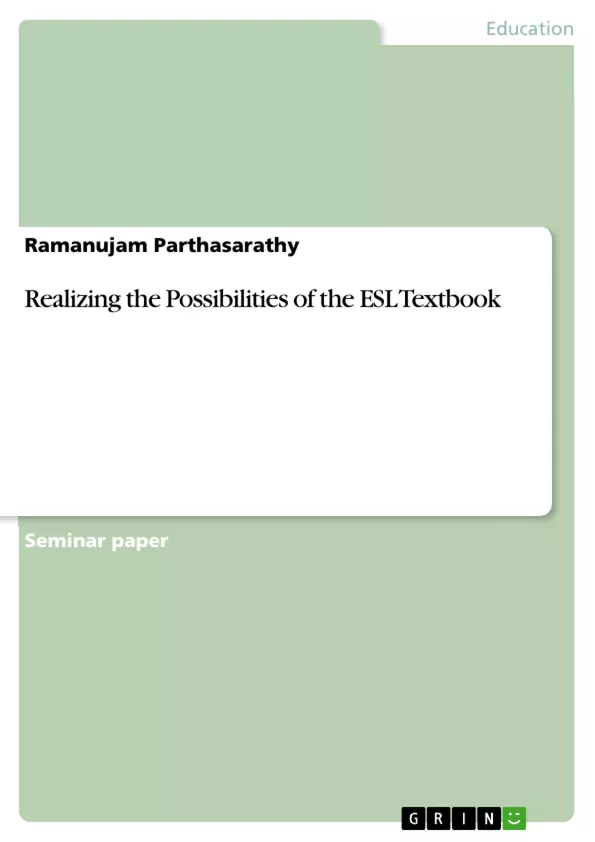Views about the English as a second/foreign language (ES/FL) textbook (as a medium) polarize. Learners, teachers and educational administrators in any ES/FL situation need a textbook, though it is unlikely that they regard the prescribed ES/FL textbook as an unmixed blessing. But the very idea of a fixed textbook -- of a pre-packaged set of learning/teaching materials -- appears to be viewed with disfavour in the English Language Teaching (ELT) literature where the trend in the last three-and-a-half decades has been towards greater negotiation and individual choice in the classroom.
This paper examines the anti-textbook argument, considers the alternatives to the textbook suggested by some experts, and finds the textbook having the potential to act as a support rather than a constraint, and fulfilling a range of needs that emerge from any teaching/learning situation. The paper also discusses the factors on which the supportiveness of the textbook depends.
Inhaltsverzeichnis (Table of Contents)
- The Textbook Problem
- Practical Factors
- The textbook ignores the linguistic-cognitive mismatch
- The textbook promotes content-based and memory-oriented learning
- The textbook lacks relevance and appeal
- The textbook lacks cultural appropriacy
- Ideological Factors
- The textbook pre-empts learning
- The textbook ignores the learner
- The textbook as a product of Western cultural values
Zielsetzung und Themenschwerpunkte (Objectives and Key Themes)
This paper aims to analyze the limitations of ESL textbooks in the Indian context, exploring both practical and ideological factors that contribute to their ineffectiveness. The author argues for a re-evaluation of the role of textbooks in ESL teaching and learning, emphasizing the need for materials that are more relevant, engaging, and culturally appropriate. Key themes addressed in the text include:- The mismatch between the linguistic and cognitive levels of learners and the content of ESL textbooks
- The promotion of content-based and memory-oriented learning by textbooks
- The lack of relevance and appeal of textbooks to the specific needs and interests of learners
- The cultural inappropriacy of many ESL textbooks
- The limitations of centrally produced textbooks in addressing individual learner needs
Zusammenfassung der Kapitel (Chapter Summaries)
The first section of the paper focuses on the "Textbook Problem," outlining a widespread discontent with ESL textbooks among both teachers and scholars. This discontent is attributed to both practical factors, such as the mismatch between learners' linguistic and cognitive levels and the content of textbooks, and ideological factors, such as the pre-emptive nature of centrally produced textbooks.
The "Practical Factors" section explores four key issues: the linguistic-cognitive mismatch, the promotion of content-based and memory-oriented learning, the lack of relevance and appeal, and the cultural inappropriacy of many textbooks. These issues are illustrated with examples from the Indian context.
The "Ideological Factors" section delves deeper into the limitations of centrally produced textbooks, arguing that they often pre-empt learning by ignoring individual learner needs. This section also examines the influence of Western cultural values on the design and content of textbooks.
Schlüsselwörter (Keywords)
The key concepts explored in this paper include ESL textbooks, linguistic-cognitive mismatch, content-based and memory-oriented learning, relevance, cultural appropriacy, centrally produced materials, and learner needs. The author examines the role of ESL textbooks in the Indian context, highlighting their limitations and suggesting a need for a more learner-centered approach to textbook design and use.- Arbeit zitieren
- Dr. Ramanujam Parthasarathy (Autor:in), 2006, Realizing the Possibilities of the ESL Textbook , München, GRIN Verlag, https://www.hausarbeiten.de/document/182247


